-

人教版新目标初中英语九年级上册I like music that I can dance to教案
教学目标: 1. Express preferences2. Talk about one’s likes and dislikes and the reasons3. Learn to express one’s opinions 4. Learn to write a reply 语言功能: 1) Talk about one’s preferences, using t he relative clause2) Talk about people’s likes and dislikes and the reasons3) Talk about opinions语言结构: Relative clauses with that and who语言目标:What kind of music do you like?I like music that I can sing along with.I love singers who write their own music.We prefer music that has great lyric.重点词汇及短语:heart, photography, interest, class, whatever, miss, okay, expect, sweet, taste, itself, laboratory, cancer, increase, biscuit, main, care, prefer… to…, remind somebody of …, dance to, sing along with, be sure to, interest somebody, make somebody adj., to be honest, suit somebody, on display, catch up教学重难点:What do other people think of the different kinds of things? How to express one’s opinions? 学习方式:讨论,合作学习情感目标:通过本单元的学习,能提高学生的艺术鉴赏能力和审美情趣,并引导学生养成健康的饮食习惯。课时安排5课时第一课时:Section A: 1a-2c第二课时:Section A : 3a-4第三课时:Section B:1-2c, Self check2第四课时:Section B: 3a-4, Self check1第五课时:Self check ReadingI like music that I can dance to.

人教版新目标初中英语九年级上册I used to be afraid of the dark教案
内容提示1.本单元主要内容是学会used to结构。Used to +动词原形表示过去经常、以前常常,只用于过去式中,用来表示现在已不存在的习惯或状态。例如:They used to play football together.他们过去常在一起蹋足球。(现在不在一起踢了)2.used to的疑问形式和否定形式为Did you use to…?和I didn’t use to… 也可以用Used you to…?和I used not to…但现在多使用前者。例如:Did you used to swim in the river? 你过去常在河里游泳吗?I didn’t use to play the piano. 我以前并不经常弹钢琴。教学目标一、学习目标(Language Goal) 1.学会陈述自己过去常做的事情。2.学会陈述自己过去的爱好等。3.能够表达自己现在和过去在外表、性格、娱乐等方面的变化。4.能够表达朋友、家人等现在和过去的变化。二、语言结构(Language Structures) 1.I used to be short when I was young. 我年轻时个子很矮。 2. —Did you use to have straight hair? 你过去是直发吗?—Yes, I did. 是的。 3. —Did you use to play the piano? 你过去弹钢琴吗?—No, I didn’t. 不,我不弹。 4.I used to be afraid of dark. 我过去害怕黑暗。 5.I’m terrified of the snakes. 我害怕蛇。

人教版新目标初中英语九年级下册By the time I got outside, the bus had already left教案
Ⅰ. Teaching Aims and Demands1. Knowledge Objects(1) Key Vocabularyoversleep(2) Target LanguageWhat happened?I overslept. And by the time I got up, my brother had already gotten in the shower.2. Ability Objects(1) Teach the students to use the new words.(2) Train the students to narrate past events with the Past Perfect Tense.(3) Train the students' listening and speaking skills with the target language.3. Moral ObjectIt’s a good habit to go to bed early in the evening and get up early in the morning. So you’ll never be in a hurry in the morning.Ⅱ. Teaching Key Points1. Key Vocabularyoversleep2. Target LanguageNarrate past events with the Past Perfect TenseⅢ. Teaching Difficult Points1. Train the students to narrate past events with the Past Perfect Tense.2. Train the students to understand the target language in spoken conversation.Ⅳ. Teaching Methods1. Thinking of examples from the students' real lives.2. Making sentences by looking at the pictures.Ⅴ. Teaching AidA tape recorderⅥ. Teaching ProceduresStep I Revision1. Revise the language points in Unit 8.Ask some questions like this: What volunteer work would you like to do?Help the students to answer, I’d like to…/I love to…/I hope to2. Practice the dialogue in Activity 3c on page 62 again. Get students to role play the similar dialogues with the following.

人教版新目标初中英语九年级下册Rainy days make me sad教案
1. 教材分析本单元以how do things affect you?为话题, 从颜色、天气、音乐、广告、产品等方面谈论了外界事物如何影响人的心情。要求学生掌握表达某物或某事给人带来的感觉、看法或影响等。共设计了四个部分的内容:Section A 该部分有4个模块:第一模块围绕Which restaurant would you like to go to?这一话题展开思维(1a)、听力(1b)、口语(1c)训练;第二模块围绕How does music affect you? 进行听力(2a-2b)、口语训练(2c);第三模块继续围绕how do colors in the restaurant affect you这一话题展开训练,训练形式为阅读和问题体验(3a)和小组活动(3b);第四模块仍就How do things affect you这一话题以调查的形式展开讨论。Section B该部分有4个模块:第一模块围绕产品广告对人们的影响这一话题以“配对”(1a)与“列举”(1b)两种形式展开训练;第二模块继续围绕How do things affect you? 进行听力(2a-2b)、口语对话训练(2c);第三模块围绕“Advertising”这一话题展开阅读(3a-3b)和写作(3c)训练;第四模块围绕How posters affect you这一话题以口语训练形式展开小组活动。

人教版新目标初中英语九年级下册Could you please tell me where the restrooms are教案
Step Ⅰ RevisionCheck homework. Ask a few students to read the article in 3a.Then ask a few students to read their guides.Step Ⅱ Part 1Look at the words in the box. Ask a student to read them. Make sure the students understand the meaning of the words. You are to fill in the blanks with the words. In some cases, students may need to use another form of the word, for example adjusting for tense or subject/ verb agreement.Ask students to fill in the blanks on their own.Check the answers. Step ⅢPart 2Go through the instructions with the class.Look at the example with the students.Ask students what the answer would be.Ask a student to read the question and answer it.Excuse me, could you tell me where the bank is, please?The bank is across the street from the shopping malt.Get students to complete the work in pairs.Check the answers. Ask a few students to read their questions.Step Ⅳ Just for Fun!Ask all the students to read the conversation. Ask: What is funny about this cartoon? Help students to explain. A Martian is a person from the planet Mars.There is no such thing as Martian food on Earth, and the clerk looks silly because he is trying to think of where there is a Martian restaurant.Invite some pairs of students to present this conversation to the rest of the class.Step Ⅴ Summary and HomeworkIn this class, we’ve done much writing practice using the key vocabulary words and the target language presented in this unit. After class, please finish the questions in 2 in your exercise books. Then finish the exercises on pages 47~48 of the workbook as well.The Seventh Period Ⅰ Teaching Aims and Demands1. Knowledge Objects(1) Key Vocabularyimage, adventure, jealousy, hero, crime, journey, brave, no longer, show interest in, take it easy, become interested in, plain looks(2)Text:Grown-ups like cartoons, too.2. Ability Objects(1) Fast-reading to get a general idea of the text.(2) Careful-reading to get the detailed information in the text.

人教版新目标初中英语九年级下册I’ll help clean up the city parks教案
Talk about offering help (P60)I’ll help clean up the city parks.A: I’d like to work ...B: You could help ...Talk about ways to tell people about the Clean-Up Day (P61)We need to ...We can’t ...I’ll ...Talk about the work the volunteers do (P62)These three students all volunteer their time to help other people.Somebody loves to ... / helps ... / plans to ... / wants to ...A: What do you like doing?B: I like ... A: What kind of volunteer work do you think I could do?B: You could ...1. 重点词汇advertisement, fix, repair, pleasure, blind, deaf, shut, carry, specially, fetch2. 认读词汇hunger, homeless, cheer, clean-up, sign, establish, major, commitment, elementary, veterinarian, coach, similar, call-in, strategy, disabled, organization, unable, support, appreciate, donation, part of speech, pronoun, adverb, preposition, conjunction, donate, Jimmy, Sally3. 词组clean up, cheer up, give out, put off, set up, think up, take after, fix up, give away, put up, hand out, work out, at once

人教版新目标初中英语九年级下册You’re supposed to shake hands教案
教学目标:1. 掌握本单元一些重点词汇的写法和用法。2. 学会自如谈论餐桌礼仪。Step 1 RevisionAsk some students to retell the customs at the table in France in the passage in 3a.Step 2 Self checkPart 1. Fill in each bland with the correct word given. Students do the exercises by themselves at first. Then check the answers. Ask the students to comprehend the sentences and help them point out uses of some words, like “arrive (at / in) sw., spend time / money on sth , spend time / money (in) doing sth.”Part 2. Read about Fan Ling’s experience in a western restaurant. Understand the passage. Point out some key points in the passage.1. be / get used to doing sth. 习惯做某事2. begin with = start with 以….开头3. crowd v. 挤满,塞满 the crowd 人群 crowded adj. 拥挤的Then students discuss about how she would solve her problem. Ask some to share their stories with others.Part 3. Complete the crossword by looking at the sentences on the left. Then check the answers.
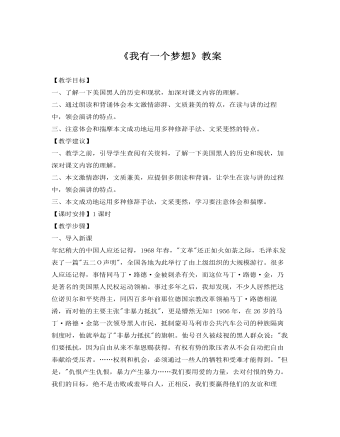
人教版高中语文《我有一个梦想》教案
一、导入新课年纪稍大的中国人应还记得,1968年春,"文革"还正如火如荼之际,毛泽东发表了一篇"五二O声明",全国各地为此举行了由上级组织的大规模游行。很多人应还记得,事情同马丁·路德·金被刺杀有关,而这位马丁·路德·金,乃是著名的美国黑人民权运动领袖。事过多年之后,我却发现,不少人居然把这位诺贝尔和平奖得主,同四百多年前那位德国宗教改革领袖马丁·路德相混淆,而对他的主要主张"非暴力抵抗",更是懵然无知!1956年,在26岁的马丁·路德·金第一次领导黑人市民,抵制蒙哥马利市公共汽车公司的种族隔离制度时,他就举起了"非暴力抵抗"的旗帜。他号召久被歧视的黑人群众说:"我们要抵抗,因为自由从来不靠恩赐获得。有权有势的欺压者从不会自动把自由奉献给受压者。……权利和机会,必须通过一些人的牺牲和受难才能得到。"但是,"仇恨产生仇恨,暴力产生暴力……我们要用爱的力量,去对付恨的势力。我们的目标,绝不是击败或羞辱白人,正相反,我们要赢得他们的友谊和理解。"
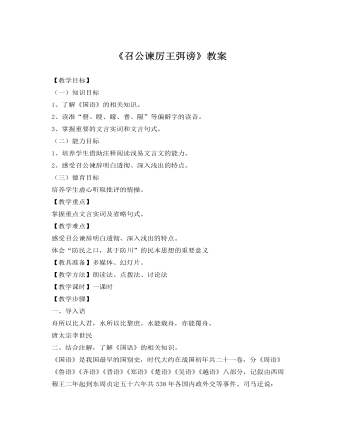
人教版高中语文《召公谏厉王弭谤》教案
六、结合讲解和译文,学生三读课文,分析内容。(一)解析第一段内容1、请找出能体现厉王性格特征的词语,说说厉王是一个什么样的人。“虐、怒、杀”暴虐凶残、残忍昏庸2、正由于厉王的行动,导致国人怎样?(从文中找出原句)谤王——道路以目3、“国人莫敢言”,是国人真的沉默无语,俯首听命了吗?没有,而是即将“在沉默中爆发”,人民在沉默中孕育着反抗,这是高压下的沉默,是火山喷发前的死寂。(二)浏览第二段本段主要是召公的谏辞。1、召公对厉王弭谤的方法有何批评?(原文)明确:是障之也。(随后用了“防民之口,甚于防川”来说明堵塞言论的危害性。并指出“为水”的最有效的办法是“导”,“为民”的最有效的办法是“宣”。)2、古代天子听政如何广开言路?明确:直接的:①使公卿至于列士献诗,②瞽献曲,③史献书,④师箴,⑤瞍赋,⑥曚诵,⑦百工谏。
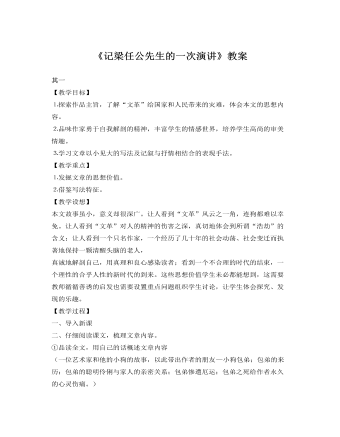
人教版高中语文《记梁任公先生的一次演讲》教案
十、教学后记:这是我实习中上的第一堂课,由于没有经验,对时间的把握不好,课堂前半部分留给学生思考回答问题的时间太多了,以至于没有完成本课时的教学内容,对《箜篌引》、《桃花扇》、《闻官军收河南河北》内容的补充要留到下节课才能完成。但课堂过程中以讨论和结果发布会的形式非常能调动学生的学习积极性,这节课学生的参与度很高,绝大部分的同学都能积极思考,并敢于回答问题。但是在学生回答问题后,有些答案很好,也是我没有思考到的。但是除了简单的表扬鼓励外,我不善于把学生的思考结果与自己的板书设计结合起来,授课过程中比较拘泥于教案,显得不够灵活。总的来说,这节课的优点是教态自然、大方,声音清晰洪亮,能调动学生学习的积极性,不足在于时间掌握不好,拘泥于教案。
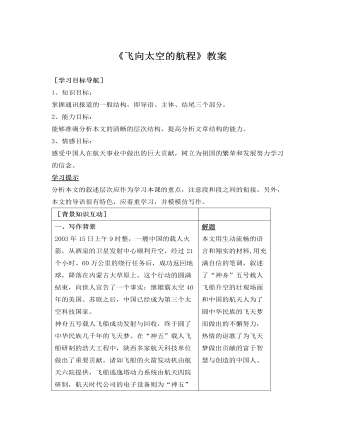
人教版高中语文《飞向太空的航程》教案
一、写作背景2003年15日上午9时整,一艘中国的载人火箭,从酒泉的卫星发射中心顺利升空,经过21个小时、60万公里的绕行任务后,成功返回地球,降落在內蒙古大草原上。这个行动的圆满結束,向世人宣告了一个事实:继雄霸太空40年的美国、苏联之后,中国已经成为第三个太空科技国家。神舟五号载人飞船成功发射与回收,终于圆了中华民族几千年的飞天梦。在“神五”载人飞船研制的浩大工程中,陕西多家航天科技单位做出了重要贡献。诸如飞船的火箭发动机由航天六院提供,飞船逃逸塔动力系统由航天四院研制,航天时代公司的电子设备则为“神五”提供了“眼睛和耳朵”……可以说,飞船的升天,可以说祖国的航天事业是千千万万献身航天科技事业的幕前幕后英雄集体智慧的结晶,正是他们共同铸就了共和国“神箭”,是他们共同托起了华夏“神舟”。二、作家作品贾永、曹智、白瑞雪,新华社记者。
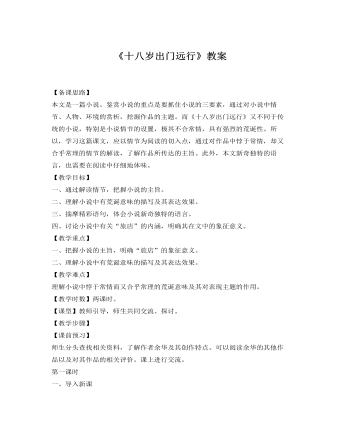
人教版高中语文《十八岁出门远行》教案
【备课思路】本文是一篇小说。鉴赏小说的重点是要抓住小说的三要素,通过对小说中情节、人物、环境的赏析,挖掘作品的主题。而《十八岁出门远行》又不同于传统的小说,特别是小说情节的设置,极其不合常情,具有强烈的荒诞性。所以,学习这篇课文,应以情节为阅读的切入点,通过对作品中悖于常情,却又合乎常理的情节的解读,了解作品所传达的主旨。此外,本文新奇独特的语言,也需要在阅读中仔细地体味。【教学目标】一、通过解读情节,把握小说的主旨。二、理解小说中有荒诞意味的描写及其表达效果。三、揣摩精彩语句,体会小说新奇独特的语言。四、讨论小说中有关“旅店”的内涵,明确其在文中的象征意义。【教学重点】一、把握小说的主旨,明确“旅店”的象征意义。二、理解小说中有荒诞意味的描写及其表达效果。
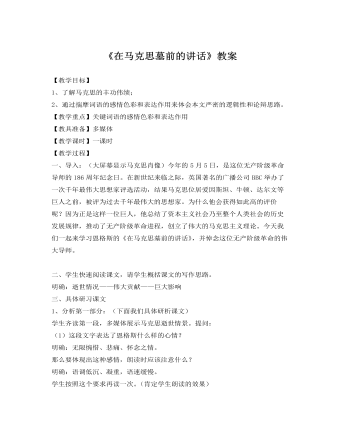
人教版高中语文《在马克思墓前的讲话》教案
【教学过程】一、导入:(大屏幕显示马克思肖像)今年的5月5日,是这位无产阶级革命导师的186周年纪念日。在新世纪来临之际,英国著名的广播公司BBC举办了一次千年最伟大思想家评选活动,结果马克思位居爱因斯坦、牛顿、达尔文等巨人之前,被评为过去千年最伟大的思想家。为什么他会获得如此高的评价呢?因为正是这样一位巨人,他总结了资本主义社会乃至整个人类社会的历史发展规律,推动了无产阶级革命进程,创立了伟大的马克思主义理论。今天我们一起来学习恩格斯的《在马克思墓前的讲话》,并悼念这位无产阶级革命的伟大导师。二、学生快速阅读课文,请学生概括课文的写作思路。明确:逝世情况——伟大贡献——巨大影响三、具体研习课文1、分析第一部分:(下面我们具体研析课文)学生齐读第一段,多媒体展示马克思逝世情景。

《手术台就是阵地》说课稿
(3)敌机不断地在上空吼叫,炮弹不断地在周围爆炸。白求恩沉思了一会儿,我要和战士们在一起,不能离开。白求恩低下头,继续给战士们做手术(板书:更危急,坚持阵地)
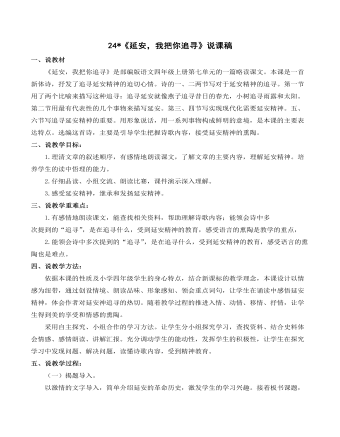
《延安,我把你追寻》说课稿
根据学生汇报的情况及诗歌学习的重难点,我再提出引导性的问题让学生思考、加深理解。如:第二节写作者追寻了哪些地方?是为了追寻什么?在小组汇报展示搜集到的资料,其他同学补充的基础上,我在视情况进行课件展示相关图片及资料,帮助学生理解。
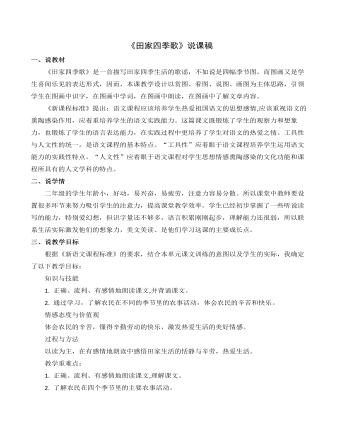
《田家四季歌》说课稿
体会感悟田家生活的恬静与辛劳,热爱生活。很好的完成了这项教学任务,充分发挥学习中的自主性,体现了学生的主体地位,也培养了学生的合作学习能力。

《现代诗二首》说课稿
作者介绍(课件展示)徐志摩是新月派的代表诗人,有些喜欢读现代诗的同学可能对他有所了解。“轻轻的我走了,正如我轻轻的来”就是徐志摩的诗句。徐志摩是新月派的代表诗人,极富浪漫,在他的笔下,花牛与草地这样极朴实的画面会变成什么样呢?

《美丽的小兴安岭》说课稿
教师先范读本段,学生边听边仔细观图,然后默读,划出作者抓住了春季的哪些景物,划出你认为作者用词准确、生动的句子,再说说这些词句好在哪里,最后指导学生边有感情地品读,边想象美景。再通过换词法理解了“抽出”的意思,通过结合实际理解了“散步”“欣赏”,体会了拟人句的作用。
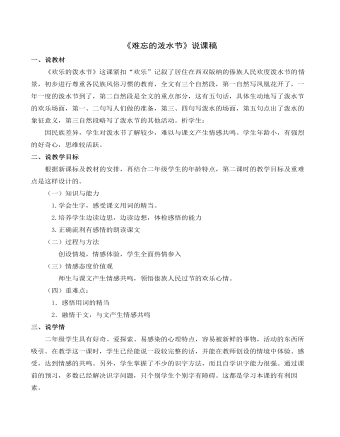
《难忘的泼水节》说课稿
A.出示象脚鼓点声,引发学生读的欲望,先读,感到“快乐、好玩”。B.创设情境:同学们,这是一个泼水的广场,来把你们的桶提起来,盆端起来,瓢拿起来, 看一看,你的好朋友在哪里,快去泼吧。学生下位,互相追赶,体验泼水节的快乐。C.读出体验
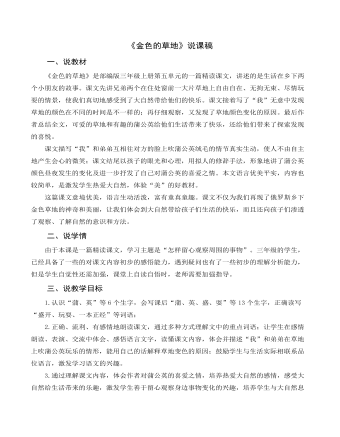
《金色的草地》说课稿
原来,蒲公英的花就像我们的手掌,可以张开、合上。花朵张开时,花瓣是金色的,草地也是金色的;花朵合拢时,金色的花瓣被包住了,草地就变成绿色的了。”这一段是课文的重点,这一句更是难点,如何让学生读中明理,读中悟情,读中享受?我充分发挥学生的个性,让学生采用多种形式的读。

